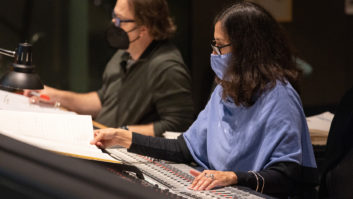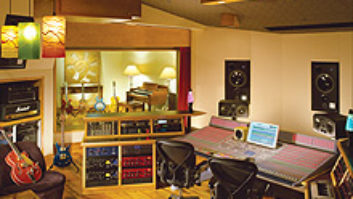 Imagine what it must have felt like for an aspiring audio professional back in the 1930s and ’40s, long before multichannel recording, long before off-the-shelf consoles or emulation reverb plug-ins, to walk into a big Hollywood scoring session for that year’s big Hollywood musical.
Imagine what it must have felt like for an aspiring audio professional back in the 1930s and ’40s, long before multichannel recording, long before off-the-shelf consoles or emulation reverb plug-ins, to walk into a big Hollywood scoring session for that year’s big Hollywood musical.
A big room…a giant room! A conductor in front of an 80-piece orchestra and a grainy, flickering reel of film projected on one of the four walls. Just a few microphones. A couple of guys in white shirts and ties tucked away into a tiny control room up above or off to the side. Film reels whirling on six-foot-tall “dubbers.” But the sound out in the room… Wow. It must have been magic. Nothing outside of a fine concert hall could match the energy. There was no “music-studio” equivalent.
At the time of the Golden Age of Film Scoring, the recording industry was mostly still hiding out within the radio industry. That would change, of course, in the late 1940s and on into the 1950s, when the modern recording industry would emerge. But even today, when technological changes have led to the creation of multi-room studio complexes, private studios, destination studios, post-production studios, garage studios, bedroom studios, mobile studios, project studios, producer-owned studios, mix-only studios, rehearsal studios, laptop studios, hybrid studios, podcast studios and every other kind of studio that might be imagined, film scoring stages occupy the rarefied air. After 100 years, they still sit atop the high-end, critical listening studio food chain.
TRADITION MEETS MODERN DAY

You can probably count on hands and toes the number of true, old-style film scoring stages currently around the world; the ones that can accommodate a 100-piece orchestra, with enough mics and cue stations, a modified tracking console, and the cubic volume and timeworn acoustic signature to deliver a high-dollar, high-pressure score heard from thousands of screens and millions of iPhones.
Of course, Oscar-worthy scores can be done on a keyboard, with samples, or section by section, supplemented with virtual instruments. They can be done with a solo cello in a Berlin home studio. They can be done in Seattle or Salt Lake or Charlotte. Plenty of high-quality, high-end videogame scores are done at Ocean Way in Nashville. But few places can host the city philharmonic and reliably deliver quality recordings for a theatrical blockbuster or Grammy-winning Best Classical Recording, while under the constant pressure of thousands and thousands of dollars an hour, with zero downtime save union breaks.
There are examples in Berlin, London, Paris, Moscow and Mumbai. In Italy and Spain and China. Three of those stages are in Los Angeles: the Barbra Streisand Scoring Stage on the Sony Pictures Studios lot; the Eastwood Scoring Stage at Warner Bros.; and the Newman Scoring Stage at Fox, renamed so during the last audio makeover in 1997 to honor the great Alfred and Lionel Newman, whose legacy continues across the family’s generations, in hundreds of memorable film scores, and above the entrance to one of the great studios in the world.

Things haven’t been easy of late for the Los Angeles-based film score community. Over the past few decades, for union, budgetary, tax-incentive and many other issues, big projects have left town for Eastern Europe, London, work-for-hire states, and keyboards and laptops. It’s rare that a television drama uses a full orchestra. For those that remain, staying current in technologies and workflow has become evermore crucial. These aren’t the types of facilities that change very often.
Rarely would one of these handful of studios revisit the live room. Maybe a couple of tiny alterations over the past 80 years, but walls, floors and ceilings remain largely as they were in 1939. The control rooms, however, have undergone significant changes, getting larger, cleaner and more accurate over the years. Still, renovations are rare, sometimes spanning decades. So when Fox Studios decided to pull out the Genelec mains system from the late 1990s and replace it with Meyer Sound’s new Bluehorn Monitoring System in July 2019, it was considered a big deal for all parties involved.
A full-on 7.1 Meyer Sound Bluehorn System doesn’t come cheap. And considering that top scoring mixers, for the past 20 years at least, have tended to travel with their personal reference monitors, or have a pre-tuned favorite system set up for their arrival, the switchover at the Newman could be considered something of a statement. They were turning the mains back on!
AND NOW, ON WITH THE STORY
Denis St. Amand spent the last 25 years of his career at Fox Studios, the first half of his years in re-recording and, since 2006, in the scoring department. He was a part of the team that put in the Neve 88R in the late-2000s. He was assistant chief engineer in 2016 when he first heard the Bluehorns and became the studio’s early champion for change. (St. Amand retired a year into the project but remained a regular visitor and consultant through the final tuning of the system in July 2019.)

“When engineers come to a studio like ours, the in-house monitors rarely got used,” St. Amand says. “Shawn Murphy would come in with B&W or ATCs, larger midfield monitors, and we would have to figure out how to implement things like bass management into our system, wire that in, track down ground loops. Then three years ago Shawn came in with a John Powell project and insisted on Miles [Rogers, of Meyer Sound] bringing in Bluehorn, which we all really wanted to hear anyway. After the project was over, we asked Shawn, ‘If we put these in, would you use them?’ His immediate answer was yes.”
Producer/engineer Armin Steiner echoed the sentiments soon after, as St. Amand recalls: “Well, Armin walked in the very first day, stopped when he walked into the room, and said, ‘What are you listening to, my boy?’ He sat down, said these are phenomenal, that he was hearing things that he knew were there but couldn’t really hear before—the definition in the woodwinds. The clarity and definition he was hearing was astounding to him.”
Early endorsements are crucial to any manufacturer entering a new, relatively small market, in this case cinema and television sound post-production and higher-end music recording. The company had introduced Acheron a few years prior and inserted itself into edit suites and small stages around L.A. and up to Skywalker Sound, over to New York and London.

Still, a technology introduction into an established market is a long game, which for Meyer Sound has meant six years of Bluehorn research and development followed by ongoing, heavily personalized marketing rollouts. The team at Meyer Sound, led in L.A. and around the world for many years by Steve Shurtz and now represented by Miles Rogers, Business Development Manager, Cinema and Content Creation Markets, knew that the acceptance of Bluehorn would be a process.
Prior to becoming the point person for cinema sound at Meyer, Rogers spent three years in the engineering department at the USC School of Cinematic Arts, followed by five years as a field service engineer at Avid during the introduction of the ICON, D-Command and D-Control stampede through Hollywood. He established a vast network of relationships, which serves him well to this day.
“The market had been divided in an interesting way over the years into cinema loudspeakers and music loudspeakers,” Rogers says. “With our standard cinema line, the Acherons and such, we reached that point in development where it led to the Bluehorn System, which introduces the next step in loudspeaker technology available.
“Then we thought, ‘Who are the most demanding engineers on the post-production side?’” he continues. “The scoring mixers! High sample rates, crazy, pressure-filled sessions, super-demanding with performance. If we can create a product for their workflow, we thought, then we have a technology that can scale in both directions. The Bluehorn System works for the market as it’s defining itself right now. People are building these mid-sized immersive rooms that have to work for both theatrical and Atmos Home Entertainment. Bluehorn bridges that gap. It operates with the precision and detail of a near-field speaker, but it can also go to the SPLs of a main system, with clean, consistent power. And it has life.”
THE SYSTEM AT THE NEWMAN

Back in 2016, when Shawn Murphy requested a temporary Bluehorn package for his work on the score for The BFG at Sony, Meyer Sound set up a portable system in Los Angeles to move around for demos and loaned out when requested. One week after Murphy was finished with the tracking, Bluehorn was officially introduced to the world at Mix Presents Sound for Film & Television, on the Sony lot. That traveling system followed Murphy to Fox for his work on Ferdinand. It was then left there for a few more projects, and Fox was hooked.
The studio actually purchased the system long before it went in. They simply had to wait for sufficient down time, finally finding it in July 2019. Though Fox purchased and prepped a fullblown immersive sound package, those ceiling and additional wall speakers are still in storage, awaiting Phase 2. The way things are moving so fast in Dolby Atmos Home and Dolby Atmos Music, having become established and solidified in Dolby Cinema, Phase 2 can’t be far off.
As it stands right now, three Bluehorn Systems sit across the front, LCR. Meyer Sound HMS-12s replaced the wall surrounds, and the bump up to 7.1 from 5.1, with modes set up for both formats in the Neve 88R monitor bus, required a couple of more HMS-12s across the back wall. The size and fit of the Bluehorn Systems proved most fortunate. There was no need to rebuild the soffit structure. The Bluehorn LCR has its own GALAXY control system.
Four Meyer Sound X-400 subwoofers, now set up in a cardioid configuration, complete the package. “Early on at Fox, they would get low frequency energy seeping through the glass,” Rogers says. “And of course they thought it would be nice to attenuate that level bleeding on to the scoring stage. So we came up with a cardioid configuration that not only attenuated the energy to the stage, but it ended up reducing some boundary cancellations at the mix position. The LFE was smoothed out substantially.”
TRANSLATION, ROOM TO ROOM

The development of a new piece of hardware or software requires a point of reference, however that might be determined. Content is no different, audio included. It must go through its own production and post-production (mixing) process, and to maintain quality throughout the chain, it helps to have trust in the truth of what comes out of a speaker, no matter the name on the grille. Then take that trust, and integrate it throughout the facility.
Some edit suites and dub stages on the Fox Studios lot have had Acheron Designer systems in place for years. Andy Nelson, an A-list, Oscar-winning re-recording mixer based nearby, was also an early advocate because of the way the music mixes were coming to the final mix, well-balanced and settling right into the final dub. The early anecdotal plaudits abound, most of it mentioning that late-stage fixes and pickups are fewer.
“The whole conversation around the Bluehorn System has been telling people that they need to check out new technologies driving the loudspeaker industry,” Rogers says. “If the whole point of your monitor system is that it translates into the other rooms—and that you have a place that serves as a reference—this Fox project is what Bluehorn is all about.”
Erin Rettig, who replaced St. Amand as Scoring Engineer, came out of sound editing on the Fox Studios lot, where he had some experience with Meyer Sound Acheron monitors. A little less than two years ago he became Supervising Engineer of the scoring stage and was thrust into the project, co-driving its implementation and completion alongside Marc Gebauer.
“Since the Bluehorn System has been installed, as a group the scoring mixers have shown a great deal more confidence in how these will translate,” Rettig says. “Some have brought in their own speakers, compared, and decided that it was not really necessary anymore. Quite a few who have since stopped bringing their own.”
Well, it was three years in coming for Meyer Sound and Fox, following those six years in Bluehorn development. To Miles Rogers at Meyer Sound, it absolutely represents a next step in speaker technology. And though he is the one in the field with the customer, making them happy, he knows what those years have meant.
“I have to give a nod to Steve Shurtz,” he concludes. “I have been blessed to come up in the Meyer Sound world with Steve Shurtz as my mentor. He started the push for Meyer Sound in cinema with relationships that were built on trust.
“And the team in R&D that John Meyer has built is absolutely amazing. Paul Kohut, Jon Arneson, and many others helped make the Bluehorn System a reality. Steve Bush and Richard Hyland were there onsite. From the very beginning this was a team effort.”
What Makes a Bluehorn?
Bluehorn monitors were not designed solely for large screens and million-dollar projects. They represent a culmination, of sorts, of John Meyer’s relentless pursuit of accuracy and clarity, with true linearity across all frequencies as its base. With Bluehorn, the team, many of whom began the project in the mid-1980s with the HD-1 near-field studio monitor, ushering in the powered monitor age, looked hard at phase anomalies, while tweaking and refining every aspect of the final speaker over the course of six years, from cabinet to amplifier to horn-loaded tweeter.
“Meyer Sound has been dealing with low-distortion horns and drivers for a long, long time now,” says Miles Rogers, representative for cinema sound. “From a transfer function standpoint, you’re talking about magnitude and saying, ‘Hey, the higher dynamic range of this speaker, from the quietest to the loudest passages, we are going to be completely linear, accurate in representation across the spectrum. And we’ve done that for years.
“But then you look at the phase measurement of your transfer function, which tells you time of arrival of your frequencies,” he continues. “That gives you an interesting picture, which is that all loudspeakers essentially have a different phase characteristic—if you measure JBLs, PMCs, ATCs, Meyer Sound, whoever. All manufacturers have different phase characteristics. A totally different phase signature to them.
“The whole point of the Bluehorn System was to say, ‘Can we remove this time nonlinearity and make it phase-flat across the entire operating range. And if we do that, does it matter?’ For six years at Meyer we went through this. Make a tweak, listen, move forward. This is the amplifier technology, this is the compression driver. Test, listen. Bring in people to listen. Tweak, listen. Repeat.
“The current phase-correction algorithm we’re using was written by Perrin Meyer, John and Helen’s son. He took the code and rewrote it to make it faster and cleaner and better. The sum total of those tiny steps became this Bluehorn System.”





